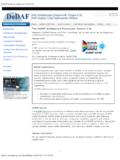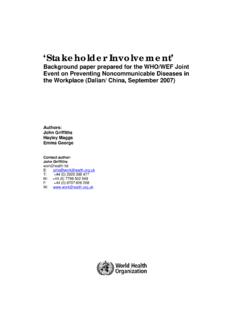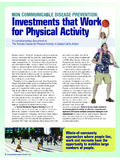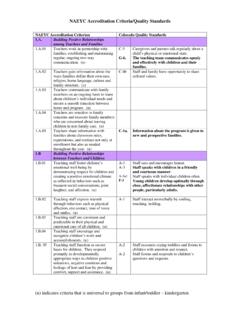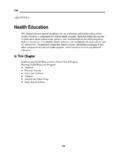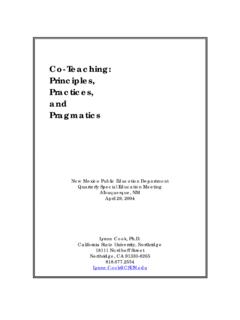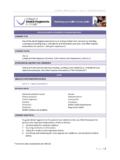Transcription of Physical Activity Evaluation - Centers for Disease Control ...
1 Physical Activity Evaluation Handbook DEPARTMENT OF HEALTH. AND HUMAN SERVICES. Centers for Disease Control and Prevention . Physical Activity Evaluation Handbook DEPARTMENT OF HEALTH. AND HUMAN SERVICES. Centers for Disease Control and Prevention National Center for Chronic Disease Prevention and Health Promotion This publication was produced by the National Center for Chronic Disease Prevention and Health Promotion of the Centers for Disease Control and Prevention. Centers for Disease Control and Prevention Jeffrey P. Koplan, MD, MPH, Director National Center for Chronic Disease Prevention and Health Promotion James S. Marks, MD, MPH, Director Division of Nutrition and Physical Activity William H. Dietz, MD, PhD, Director Technical Information and Editorial Services Branch Christine Fralish, MLIS, Chief Amanda Crowell, Writer-Editor Compiled by Sarah Levin, MS, PhD.
2 Nancy E. Hood For more information, contact Division of Nutrition and Physical Activity 4770 Buford Highway Mailstop K-46. Atlanta, GA 30041-3717. (770) 488-5692. This publication is available on the Internet at Suggested Citation US Department of Health and Human Services. Physical Activity Evaluation Handbook. Atlanta, GA: US Department of Health and Human Services, Centers for Disease Control and Prevention; 2002. Information about the Web sites of nonfederal organizations are provided solely as a service to our users. This information does not constitute an endorsement of these organizations by CDC or the federal government, and none should be inferred. The CDC is not responsible for the content of these Web sites. Publication support was provided by Palladian Partners, Inc. under contract no. 200-98-0415. Preface The landmark 1996 publication, Physical Activity and Health: A Report of the Surgeon General, identified substantial health benefits of regular Physical Activity .
3 In January 2000, Healthy People 2010 released a set of 10 priority health indicators that include Physical Activity as one of the major concerns for public health attention. The Physical Activity and Health Branch of CDC's Division of Nutrition and Physical Activity recently partnered with other national organizations to develop guidelines for increasing Physical Activity across an array of settings and populations. These include promoting Better Health for Young People through Physical Activity and Sports. Available at promoting Physical Activity : A Guide for Community Action. Available at National Blueprint: Increasing Physical Activity Among Adults Age 50 and Older. Available at Increasing Physical Activity : A Report on Recommendations of the Task Force on Community Preventive Services. Available at We hope the recommendations and strategies described in these and other resources will help users improve existing programs and develop new approaches.
4 As innovative programs emerge and evolve, ongoing program Evaluation must be used to Measure the effectiveness of new and enhanced interventions. Determine whether funds and other resources are being used efficiently. Assess the appropriateness and effectiveness of recommended interventions in different settings and populations. Demonstrate accountability and influence policy makers. Evaluate the effects of comprehensive state approaches. This handbook provides tools for state and local agencies and community-based organizations that are evaluating Physical Activity programs. We hope these tools will help users demonstrate program outcomes and continuously improve Physical Activity promotion programs. The goal is clear: we need to get moving! Program Evaluation will enhance our knowledge of the resources, methods, and strategies necessary to increase Physical Activity .
5 William H. Dietz, MD, PhD. Director, Division of Nutrition and Physical Activity National Center for Chronic Disease Prevention and Health Promotion, CDC. 1.. Contents Introduction ..5. Six Steps for Evaluating Physical Activity Programs ..9. Step 1: Engage Stakeholders ..9. Step 2: Describe or Plan the Program ..13. Step 3: Focus the Evaluation ..20. Step 4: Gather Credible Step 5: Justify Conclusions ..29. Step 6: Ensure Use and Share Lessons Appendices ..37. Appendix 1: Program Evaluation Standards and How They Apply To the Six Steps of Program Evaluation ..37. Appendix 2: Guide to Community Preventive Services Recommendations ..41. Appendix 3: Theories and Models Used in Physical Activity Promotion ..43. Appendix 4: How to Write SMART Appendix 5: Indicators and Measurement Resources ..49. Appendix 6: Sample Case Studies ..55. 3.. Introduction Recognition of the importance of Physical Activity has reached a new height in America.
6 In fact, Physical Activity was recently named as one of the 10 leading health indicators in Healthy People Consequently, the imperative to evaluate our Physical Activity programs is greater than ever. Why? Physical Activity programs must be evaluated to reflect on our progress, see where we're going and where we've come from, share what we've learned with our colleagues, put money to nonduplicative use, and improve our programs. After all, we will be held accountable. Program Evaluation can be used to Influence policy makers and funders. Build community capacity and engage communities. Share what works and what doesn't work with other communities. Ensure funding and sustainability. Program Evaluation can be conducted using these six major steps: Engage stakeholders. Describe or plan the program. Focus the Evaluation . Gather credible evidence.
7 Justify conclusions. Ensure use and share lessons learned. What Is Evaluation ? Evaluation is the systematic examination and assessment of features of an initiative and its effects, in order to produce information that can be used by those who have an interest in its improvement or effectiveness. 2. 1. US Department of Health and Human Services. Healthy People 2010. 2nd ed. With Understanding and Improving Health and Objectives for Improving Health. 2 vols. Washington, DC: US Government Printing Office; 2000. 2. WHO European Working Group on Health Promotion Evaluation . Health Promotion Evaluation : Recommendations to Policymakers. Copenhagen: World Health Organization; 1998. 5.. Physical Activity Evaluation Handbook Program Evaluation differs from basic research in that its primary aim is not to add to a body of knowledge but to learn how to improve a program.
8 Other distinctions include the following: Evaluation is controlled by those involved (the stakeholders) instead of being rigorously designed by an investigator. The steps of Evaluation vary considerably from those of basic research. Standards of Evaluation include usefulness, feasibility, accuracy, and fairness rather than internal and external validity. Evaluation assesses merit, worth, and importance rather than emphasizing associations. Evaluation is holistic and flexible by design to allow for changes and unexpected circumstances rather than being tightly controlled. Evaluation methods are both quantitative and qualitative. Evaluation is ongoing rather than being limited to a specific timeframe. The scope is broad, in an attempt to be integrative, rather than narrowly focused. Judgments from Evaluation depend on agreed-upon or specifically stated values of a stakeholder rather than being value-free.
9 Use of the data is imperative not just to further knowledge and help improve similar programs through publication, but also to build capacity or improve a program. How? In 1999, CDC published the Framework for Program Evaluation in Public Health (available on-line at ).3 The publication outlines six steps for program Evaluation engage stakeholders, describe the program, focus the Evaluation design, gather credible evidence, justify conclusions, and ensure use and share lessons learned. This handbook uses the Framework for Program Evaluation in Public Health, its companion, An Evaluation Framework for Community Health Programs,4 and promoting Physical Activity : A Guide for Community Action5 as guiding documents to outline these six steps as they relate to Physical Activity program Evaluation . 3. Centers for Disease Control and Prevention.
10 Framework for Program Evaluation in Public Health. MMWR. 1999;48(No RR-11). 4. The Center for the Advancement of Community Based Public Health. An Evaluation Framework for Community Health Programs. Durham, NC: The Center for the Advancement of Community Based Public Health; 2000. 5. US Department of Health and Human Services. promoting Physical Activity : A Guide for Community Action. Atlanta, GA: US Department of Health and Human Services, Centers for Disease Control and Prevention;. 1999. 6. Introduction Features unique to this handbook include We challenge you to think outside the box when you consider your own Evaluation plans. We provide KidsWalk-to-School examples to illustrate the main points. CDC's KidsWalk-to-School is a community-based program that aims to increase opportunities for daily Physical Activity by encouraging children to walk to and from school in groups accompanied by adults.










